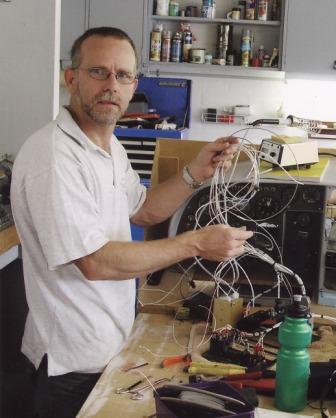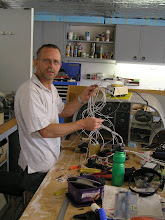You may have noticed in earlier posts that when I bought the aircraft it already had some work done on a scrathbuilt engine cowl plug. Here are a couple of shots of this early work.

Although this was a great start I wanted to change a few things
Several things hapened early on,
1. I wanted to make changes to this design to lower the firewall bottom edge to line up with an augmentor system based on Mark Langford's work
2. the air inlet had to be made more aerodynamic so the C150 box had to go
3. I got given an old cowl off a KR-2/O-200 to work with.


So off came the early work, the C150 air box went back to it's owner and I started sizing up the O-200 cowl.
After many measurements it became obvious this cowl was meant to be used with a 3" prop extension. If I lined the spinner face up with the prop flange the cowl wouldn't fit over the rocker covers.
If I pulled it forward to clear the covers the prop flange was inside by 3". Also the spinner flange was nearly 13" diameter and looket all out of proportion on a KR2. In an earlier post I built a spinner mockup (as practice) based on a C152 shape and 10" diameter (same as Langford's)

Next the inlets were over 5" diameter each, enough air to cool a high power 6 not a 100hp 4 cylinder. Target for this (considering I'm doing augmentation and plenums) is 3" as shown.

I found inlet bellmouths that were made for turbochargers on drag cars. These were 3" and made from spun aluminium. Later I may bond them in but for now they give a good idea of the final size. Also I have a 10" spinner blank in place as a reference to future cutting and shunting. Also note the ram air inlet, I think it is ugly so it too has to go. Yes I will be keeping some of this cowl.

So here is the starting point, the mock spinner is in the right location on it's mock 6" extension. The cowl is in the right location, pulled forward enough to clear the rocker covers by 1/2". I now have a 3" gap at the back and 3" to work with at the front.

Next the inlets were over 5" diameter each, enough air to cool a high power 6 not a 100hp 4 cylinder. Target for this (considering I'm doing augmentation and plenums) is 3" as shown.

I found inlet bellmouths that were made for turbochargers on drag cars. These were 3" and made from spun aluminium. Later I may bond them in but for now they give a good idea of the final size. Also I have a 10" spinner blank in place as a reference to future cutting and shunting. Also note the ram air inlet, I think it is ugly so it too has to go. Yes I will be keeping some of this cowl.

So here is the starting point, the mock spinner is in the right location on it's mock 6" extension. The cowl is in the right location, pulled forward enough to clear the rocker covers by 1/2". I now have a 3" gap at the back and 3" to work with at the front.
But that spinner flange is way too big. A piece of electrical conduit is used as a guide to check the curve I would like to end up with. If you look at the earlier photo is doesn't curve and doesn't look at all aerodynamic.

Another shot of that step.

First of all I need to fill in that aft 3" gap. I started by using the old cowl as a plug and laid up a cpuple of layers of CSM.

After that was cured I made a cut 1" in frm the aft edge and inserted the piece I just made. This shot is the popcicle sticks hot glued into place to make a frame to hold the new piece while I glass it.

Here you can see the insert in place.

Extended top cowl in place now supports the lower cowl. It is quite obvious from this one how much I had to move the cowl forward.

I had a friend cut me some MDF disks in 1/4 inch sizes from 10" to 11" to use to stabilise the spinner flange as a neck it down.

Another shot of that step.

First of all I need to fill in that aft 3" gap. I started by using the old cowl as a plug and laid up a cpuple of layers of CSM.

After that was cured I made a cut 1" in frm the aft edge and inserted the piece I just made. This shot is the popcicle sticks hot glued into place to make a frame to hold the new piece while I glass it.

Here you can see the insert in place.

Extended top cowl in place now supports the lower cowl. It is quite obvious from this one how much I had to move the cowl forward.

I had a friend cut me some MDF disks in 1/4 inch sizes from 10" to 11" to use to stabilise the spinner flange as a neck it down.
A Sabre 6" extension is now in place and is the reference for this work.

Starting on the top cowl I made my cuts. I wanted to start the curve down to the spinner quite a way aft so the centre cuts were quite long.

Here I have clecoed the flange into it's new location. There is quite a lot of spring in the glass as the builder of this cowl built it too strong (and heavy hence the reason it is not on a flying KR-2)

Side view of the new profile. Starting to look good already. Roll back to the start to remind yourself of what it started like. As you can see the bottom cowl is still to be done.

Glass on the inside to hold the fingers in place.

Layout on the lower cowl.

Lower cowl cut and clecoed into place.

Starting on the top cowl I made my cuts. I wanted to start the curve down to the spinner quite a way aft so the centre cuts were quite long.

Here I have clecoed the flange into it's new location. There is quite a lot of spring in the glass as the builder of this cowl built it too strong (and heavy hence the reason it is not on a flying KR-2)

Side view of the new profile. Starting to look good already. Roll back to the start to remind yourself of what it started like. As you can see the bottom cowl is still to be done.

Glass on the inside to hold the fingers in place.

Layout on the lower cowl.

Lower cowl cut and clecoed into place.













No comments:
Post a Comment